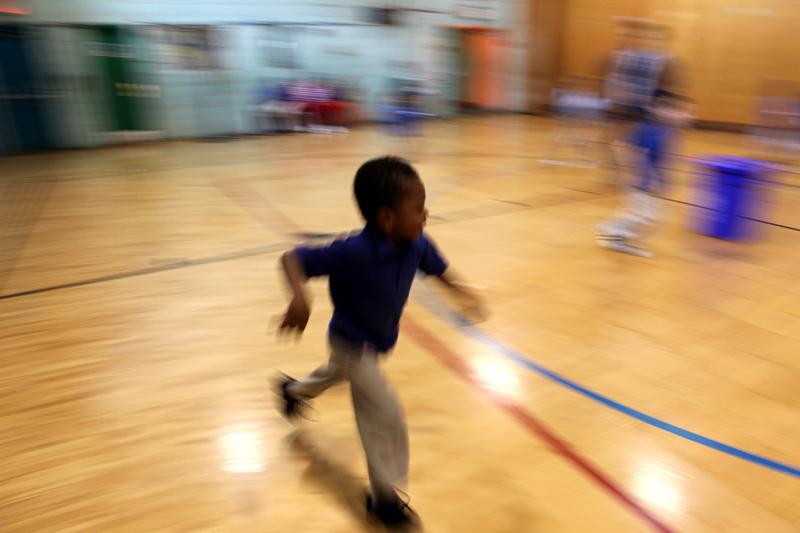
Thousands of kids stream into Fort Greene Park each afternoon as local middle and high schools let out, but Daquan McKethan is no longer among them.
On a recent Wednesday, the seventh-grader was two blocks away, playing basketball at his middle school, Fort Greene Preparatory Academy, where he now stays until 6 p.m. every night. In contrast, he was in the park, across from a public housing project in northwest Brooklyn, almost every day last year.
“Sometimes you don’t have a good time in the park,” the slight 12-year-old said, haltingly. “Sometimes people push people, and you get hurt and you get upset. Here, if someone gets hurt, someone sees it and they can help.”
Fort Greene Prep is part of New York City’s expansion of free after-school programs for middle school students. The city doubled the number of middle schools providing after-school programs this year, serving an additional 31,000 children — or more than 75,000 of the roughly 225,000 students in its public middle schools.
The programs, run by community organizations, provide thousands of kids with a place to go for three hours after school every day. And they're mostly in the lowest-performing schools across the city. Still, some child advocates questioned whether their academics were robust enough.
“After-school is really one of the equalizing opportunities, and what’s going on in New York will benefit a lot of children,” said Jennifer Davis, co-founder and president of the National Center on Time and Learning. “But I worry that we’re not going to see the kind of educational gains that we need, particularly in light of the skills we know students need to be prepared for this complex economy.”
Those wanting to see more academics offered after school said middle school was a critical time when at-risk students often flounder and fall behind academically, sometimes for good. One study shows that a sixth-grader in a high-poverty school who fails English or math has a 75 percent chance of dropping out of high school.
At Fort Greene Prep, 85 percent of the students are not reading at grade level, and 92 percent didn't pass the state math exam. Advocates said it was possible to combine engaging and fun activities with academic enrichment and that the city should make this an explicit goal.
But city officials pushed back against judging the programs by academic measures.
“It’s very important to be clear what after-school is and isn’t,” said Deputy Mayor Richard Buery, who has overseen the expansion. “It’s not designed to be three hours of academic instruction. We should never look to after-school to do what a school isn’t able to do.”
Besides, officials at Daquan’s school said recently, the impact of their after-school program was not limited to the afternoon.
“It’s totally different this year,” said Paula Lettiere, principal of Fort Greene Prep, a middle school with about 250 students. “There would be incidents, things that would happen in the park, and then they would go up on Facebook. We would have to deal with it during the day, and it would take away from learning. That no longer happens.”
The city is now figuring out a process to evaluate program quality and impact; Buery cautioned against making the evaluations too academically focused.
“I don’t ask my kid’s piano teacher to improve their test scores. All of sudden when it’s District 19 and District 23, why are we asking them to do that, too?” he said, referring to two high-poverty Brooklyn school districts.
“Working-class and poor kids need art and music, too. Kids in District 23 shouldn’t have to choose between learning how to read and developing as a young person, and we shouldn’t make them choose," he said. "It’s a false choice. Because we failed you in school all day, you can’t have these programs to develop your soul?”
At Fort Greene Prep, where the program is run by University Settlement, 100 students are enrolled for 90 slots. Principal Letierre said about 95 kids show up every day. Like most educators, she saw the social and emotional work of the after-school program as inseparable from the academics.
“We have kids who would show up at the PTA meetings without their parents, just to get a snack,” said the longtime educator, who made sure that her afternoon program provided supper. “We have kids whose parents work in the evening, so they are literally eating every single meal with us. Some of them are alone from dismissal until 10 at night.”
It is too early to measure the success of the program at Fort Greene Prep, but attendance is up and behavior problems during the regular school day are down. Homework completion, which hovered at 50 percent last year, was close to 100 percent so far this year for children who stayed after school.
You can read the full version of this story here. It was produced by The Hechinger Report, a nonprofit, independent news website focused on inequality and innovation in education. Read more about extended learning time.
